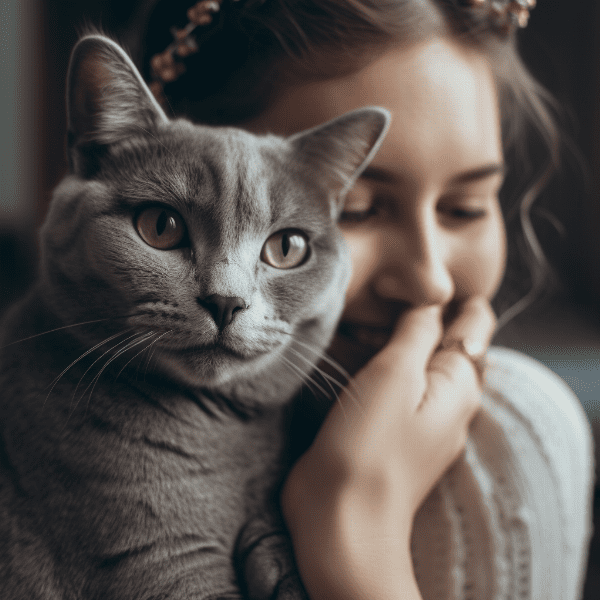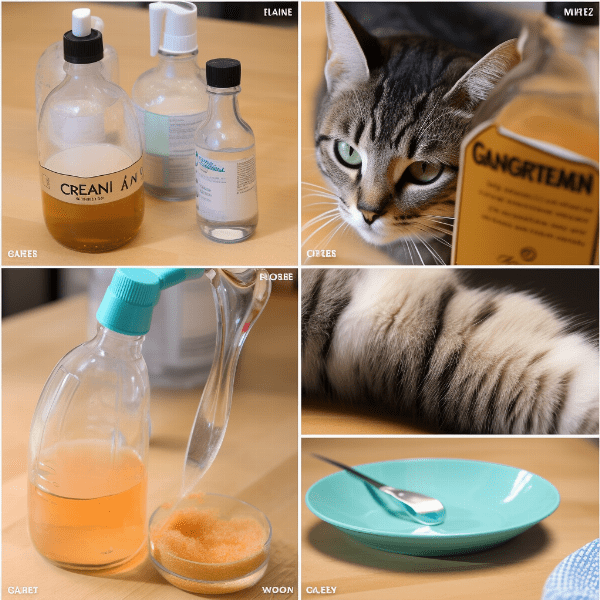Table of Contents
- Understanding the Importance of Cat Ear Cleaning
- Why Use a Homemade Ear Cleaning Solution?
- Ingredients Needed for a Homemade Cat Ear Cleaning Solution
- Step-by-Step Guide to Making Your Own Solution
- How to Properly Administer the Solution to Your Cat
- Tips for Maintaining Your Cat’s Ear Health
- Warning Signs of Ear Infections or Other Issues
- When to Seek Veterinary Care for Your Cat’s Ears
- Final Thoughts on Keeping Your Cat’s Ears Clean and Healthy
Understanding the Importance of Cat Ear Cleaning
Cats are known for their exceptional grooming habits, but many pet owners tend to overlook the importance of cleaning their cat’s ears. Ear cleaning is an essential part of maintaining your cat’s overall health and wellbeing. Neglecting to clean your cat’s ears can lead to a range of issues, including infections, hearing loss, and other health problems.
The Role of Ear Wax in Cat Ear Health
Like humans, cats produce ear wax as a natural part of their body’s cleaning process. Ear wax is produced by the glands in the ear canal and serves several important functions, such as protecting the ear canal from foreign objects, trapping dirt and debris, and preventing infections.
However, excessive ear wax buildup can lead to blockages and inflammation, which can cause discomfort and pain for your cat. Regular ear cleaning can help to remove excess wax and prevent blockages from occurring.
Common Ear Problems in Cats
Cats are prone to a range of ear problems, including ear mites, bacterial and fungal infections, and allergies. These issues can cause itching, irritation, and inflammation, leading to discomfort and pain for your cat. By regularly cleaning your cat’s ears, you can help to prevent these problems from occurring and catch them early on if they do develop.
The Benefits of Regular Cat Ear Cleaning
Regular cat ear cleaning can provide a range of benefits for both you and your cat. By keeping your cat’s ears clean and healthy, you can:
- Prevent ear infections and other ear problems
- Reduce the risk of hearing loss
- Improve your cat’s overall health and wellbeing
- Strengthen your bond with your cat by providing care and attention
In summary, understanding the importance of cat ear cleaning is vital for maintaining your cat’s overall health and wellbeing. Regular ear cleaning can prevent infections, reduce the risk of hearing loss, and improve your cat’s quality of life. In the next section, we’ll explore why using a homemade ear cleaning solution can be an effective and safe option for your cat.
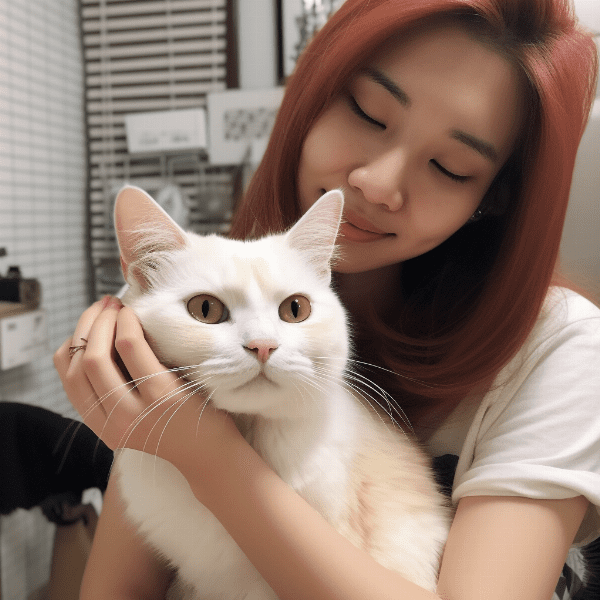
Why Use a Homemade Ear Cleaning Solution?
When it comes to cleaning your cat’s ears, there are a variety of commercial ear cleaning solutions available on the market. However, many pet owners are turning to homemade ear cleaning solutions as a natural and cost-effective alternative. In this section, we’ll explore the benefits of using a homemade ear cleaning solution for your cat.
Avoiding Harmful Chemicals
Many commercial ear cleaning solutions contain harsh chemicals and artificial fragrances that can irritate your cat’s delicate ear tissue. Homemade solutions, on the other hand, are made from natural ingredients that are less likely to cause irritation or adverse reactions.
Cost-Effective
Homemade ear cleaning solutions are often much cheaper than commercial options, making them a cost-effective choice for pet owners on a budget. Many of the ingredients used to make homemade solutions can be found in your pantry or local grocery store, making them readily accessible.
Tailored to Your Cat’s Needs
Every cat is unique, and their ear cleaning needs can vary based on factors such as age, breed, and lifestyle. Homemade ear cleaning solutions can be tailored to meet your cat’s specific needs, allowing you to customize the ingredients and concentration levels to suit their individual requirements.
Environmental Considerations
Commercial ear cleaning solutions often come in plastic bottles or packaging, contributing to environmental waste. Homemade solutions can be stored in reusable containers, reducing the amount of plastic waste produced.
In summary, homemade ear cleaning solutions offer a range of benefits, including avoiding harmful chemicals, being cost-effective, tailored to your cat’s needs, and environmentally friendly. In the next section, we’ll explore the ingredients needed to make a homemade cat ear cleaning solution.

Ingredients Needed for a Homemade Cat Ear Cleaning Solution
Making your own homemade ear cleaning solution for your cat is easy and requires just a few simple ingredients that you may already have in your kitchen. In this section, we’ll take a closer look at the ingredients you’ll need to make an effective and safe ear cleaning solution for your furry friend.
Apple Cider Vinegar
Apple cider vinegar is a popular ingredient in many homemade cleaning solutions due to its antimicrobial properties. It can help to kill bacteria and fungi in your cat’s ears, preventing infections and reducing inflammation.
Distilled Water
Using distilled water is important when making a homemade ear cleaning solution to ensure that the solution is free from any impurities that may cause irritation or infection.
Hydrogen Peroxide
Hydrogen peroxide is a mild antiseptic that can help to clean your cat’s ears and remove excess wax buildup. However, it’s important to use a low concentration of hydrogen peroxide to avoid damaging your cat’s delicate ear tissue.
Aloe Vera Gel
Aloe vera gel has anti-inflammatory properties and can help to soothe and moisturize your cat’s ears. It can also help to reduce itching and irritation caused by allergies.
Olive Oil
Olive oil can help to soften and loosen wax buildup in your cat’s ears, making it easier to remove during the cleaning process.
Essential Oils
Some essential oils, such as tea tree oil and lavender oil, have natural antimicrobial and anti-inflammatory properties that can help to prevent infections and reduce inflammation. However, it’s important to use essential oils with caution, as they can be toxic to cats in high concentrations.
In summary, making a homemade ear cleaning solution for your cat requires just a few simple ingredients, including apple cider vinegar, distilled water, hydrogen peroxide, aloe vera gel, olive oil, and essential oils (if desired). In the next section, we’ll provide a step-by-step guide to making your own homemade cat ear cleaning solution.

Step-by-Step Guide to Making Your Own Solution
Making your own homemade ear cleaning solution for your cat is a simple and straightforward process. In this section, we’ll provide you with a step-by-step guide to making an effective and safe solution for your furry friend.
Step 1: Gather Your Ingredients
Before you begin, make sure you have all the necessary ingredients on hand, including apple cider vinegar, distilled water, hydrogen peroxide, aloe vera gel, olive oil, and essential oils (if desired).
Step 2: Mix the Solution
In a clean container, mix together 1/4 cup of apple cider vinegar, 1/4 cup of distilled water, and 1/4 cup of aloe vera gel. Add in 1 tablespoon of olive oil and 1 teaspoon of hydrogen peroxide, and mix well.
If you’re using essential oils, add a few drops of your chosen oil to the mixture and mix well.
Step 3: Store the Solution
Pour the solution into a clean, airtight container and store it in a cool, dark place until you’re ready to use it. Make sure to label the container with the date and the contents.
Step 4: Administer the Solution
To administer the solution, gently tilt your cat’s head to the side and apply a few drops of the solution into their ear canal. Massage the base of their ear for 20-30 seconds to distribute the solution, then use a cotton ball or soft cloth to wipe away any excess solution and debris.
Repeat the process on the other ear, then reward your cat with a treat or praise for their cooperation.
In summary, making your own homemade cat ear cleaning solution is a simple and easy process that requires just a few ingredients and some basic equipment. By following these steps, you can provide your cat with an effective and safe ear cleaning solution that will help to keep their ears healthy and clean. In the next section, we’ll provide some tips for properly administering the solution to your cat.

How to Properly Administer the Solution to Your Cat
Administering an ear cleaning solution to your cat can be a bit tricky, especially if your cat is not used to having their ears handled. In this section, we’ll provide you with some tips and tricks for properly administering the solution to your cat.
Preparation is Key
Before you begin, make sure you have all the necessary equipment on hand, including the ear cleaning solution, cotton balls or a soft cloth, and treats or praise for your cat. It’s also a good idea to have someone to assist you in holding your cat still.
Choose the Right Time
Choose a time when your cat is relaxed and calm, such as after a nap or a meal. Avoid administering the solution when your cat is anxious or agitated.
Gentle Restraint
Gently restrain your cat by holding them firmly but gently. Avoid holding them too tightly, as this can cause them to become more agitated.
Massage the Ear
Gently massage the base of your cat’s ear for 20-30 seconds to distribute the solution. This will also help to loosen any wax or debris in the ear canal.
Wipe Away Excess Solution
Using a cotton ball or soft cloth, gently wipe away any excess solution and debris from your cat’s ear. Be careful not to insert the cotton ball or cloth too far into the ear canal, as this can cause injury.
Reward Your Cat
Reward your cat with a treat or praise for their cooperation. This will help to reinforce positive associations with the ear cleaning process.
In summary, properly administering an ear cleaning solution to your cat requires some preparation, gentle restraint, and careful application of the solution. By following these tips, you can help to ensure a safe and effective ear cleaning experience for your furry friend. In the next section, we’ll provide some tips for maintaining your cat’s ear health.
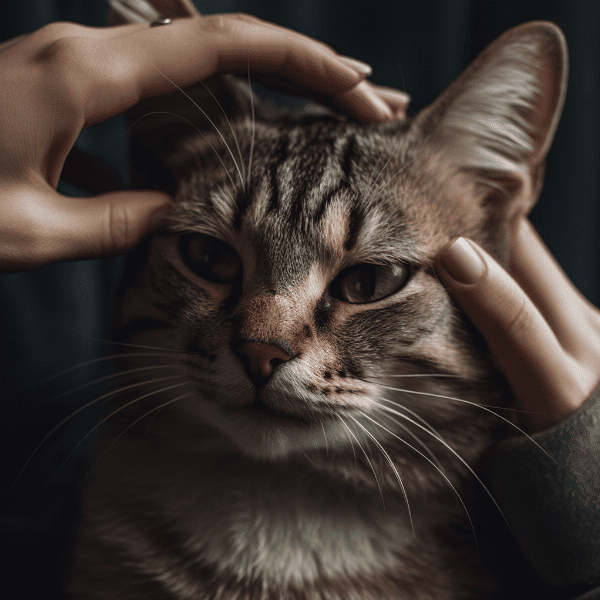
Tips for Maintaining Your Cat’s Ear Health
Proper ear cleaning is just one part of maintaining your cat’s ear health. In this section, we’ll provide you with some tips and tricks for keeping your cat’s ears healthy and clean between cleanings.
Regular Inspection
Make a habit of inspecting your cat’s ears regularly for any signs of infection, inflammation, or irritation. This can include redness, swelling, discharge, or a foul odor. Catching potential problems early can help to prevent more serious issues from developing.
Grooming
Regular grooming can help to prevent excess wax buildup and keep your cat’s ears clean. Brushing your cat’s fur regularly can help to remove dirt and debris that can accumulate in their ears.
Diet
A healthy diet can help to maintain your cat’s overall health, including their ear health. Make sure your cat’s diet is rich in high-quality protein and essential nutrients that support their immune system and promote healthy skin and coat.
Environmental Factors
Environmental factors can also impact your cat’s ear health. Avoid exposing your cat to cigarette smoke, dust, and other irritants that can cause inflammation or infection in their ears.
Professional Cleanings
If you’re not comfortable cleaning your cat’s ears or if your cat is prone to ear problems, consider taking them to a professional groomer or veterinarian for regular cleanings.
In summary, maintaining your cat’s ear health involves regular inspection, grooming, a healthy diet, and consideration of environmental factors. By following these tips, you can help to prevent ear problems and keep your cat’s ears clean and healthy. In the next section, we’ll discuss warning signs of ear infections or other issues to look out for.
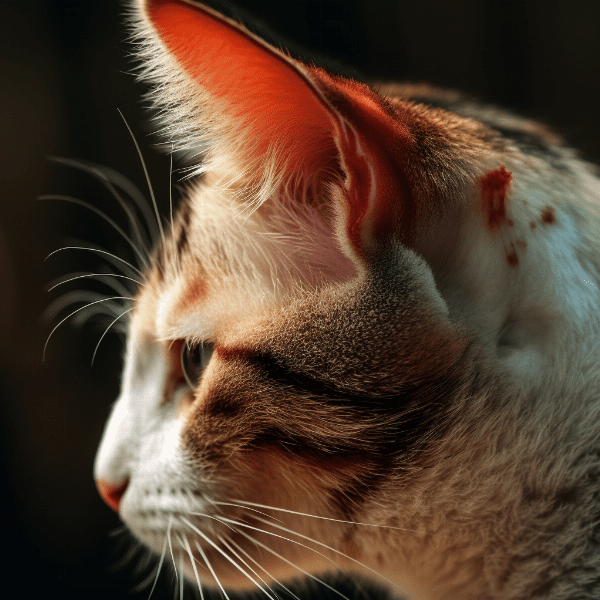
Warning Signs of Ear Infections or Other Issues
Despite your best efforts to maintain your cat’s ear health, ear infections and other issues can still occur. In this section, we’ll discuss some warning signs to look out for that may indicate an ear problem in your cat.
Foul Odor
If you notice a strong, unpleasant odor coming from your cat’s ears, this may be a sign of an infection. Ear infections can cause a foul smell due to the presence of bacteria or yeast.
Scratching or Head Shaking
If your cat is scratching at their ears or shaking their head frequently, this may be a sign of discomfort or irritation. This can be caused by a range of issues, including ear infections, allergies, or parasites.
Discharge
If you notice any discharge coming from your cat’s ears, this may be a sign of an infection or injury. The discharge may be yellow, brown, or black and can range from a thin liquid to a thick, pus-like substance.
Redness and Swelling
If your cat’s ears appear red, swollen, or inflamed, this may be a sign of an infection or allergic reaction. In severe cases, the swelling can cause the ear canal to close, leading to hearing loss.
Loss of Balance
In rare cases, ear infections or other issues can cause a loss of balance or coordination in your cat. This may be accompanied by other symptoms such as vomiting or diarrhea.
If you notice any of these warning signs in your cat, it’s important to seek veterinary care as soon as possible. Left untreated, ear infections and other ear problems can lead to more serious health issues. In the next section, we’ll discuss when to seek veterinary care for your cat’s ears.
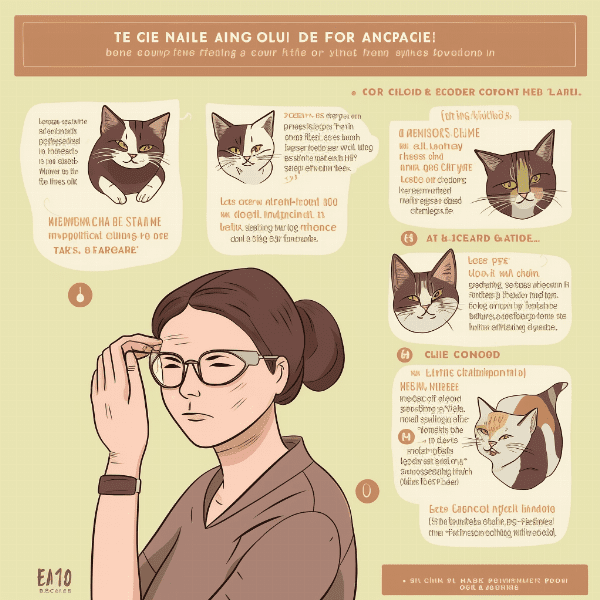
When to Seek Veterinary Care for Your Cat’s Ears
While homemade ear cleaning solutions can be effective in maintaining your cat’s ear health, it’s important to know when to seek veterinary care for your furry friend. In this section, we’ll discuss some situations where veterinary care may be necessary.
Persistent Symptoms
If your cat is showing persistent symptoms of an ear problem, such as itching, scratching, or discharge, despite your best efforts to manage the issue, it may be time to seek veterinary care. Your veterinarian can examine your cat’s ears and determine the underlying cause of the problem.
Excessive Discharge
If you notice excessive discharge or bleeding coming from your cat’s ears, this may be a sign of a serious infection or injury. It’s important to seek veterinary care as soon as possible to prevent the condition from worsening.
Head Tilt or Loss of Balance
If your cat is tilting their head to one side or showing signs of loss of balance, this may be a sign of a more serious ear problem such as an infection that has spread to the inner ear. This requires immediate veterinary attention.
Previous Ear Infections
If your cat has a history of recurring ear infections or other ear problems, it’s important to seek veterinary care to determine the underlying cause and prevent future occurrences.
In summary, while homemade ear cleaning solutions can be effective in maintaining your cat’s ear health, it’s important to know when to seek veterinary care for your furry friend. Persistent symptoms, excessive discharge or bleeding, head tilt, loss of balance, and a history of ear problems are all signs that it’s time to seek professional veterinary care.

Final Thoughts on Keeping Your Cat’s Ears Clean and Healthy
Proper ear care is an important part of maintaining your cat’s overall health and wellbeing. By using a homemade ear cleaning solution and following the tips and tricks outlined in this article, you can help to prevent ear problems and keep your furry friend’s ears clean and healthy.
Remember to regularly inspect your cat’s ears for any signs of infection or irritation, and to groom them regularly to prevent excess wax buildup. Follow the step-by-step guide for properly administering the ear cleaning solution, and seek veterinary care if you notice any persistent or concerning symptoms.
With proper care and attention, you can help to ensure that your cat’s ears stay healthy and free from infection or discomfort. By incorporating regular ear cleaning into your cat’s grooming routine, you can help to prevent more serious health issues from developing and keep your furry friend happy and healthy for years to come.
Thank you for reading this guide on how to make a homemade cat ear cleaning solution and maintain your cat’s ear health. We hope you found it informative and helpful.
